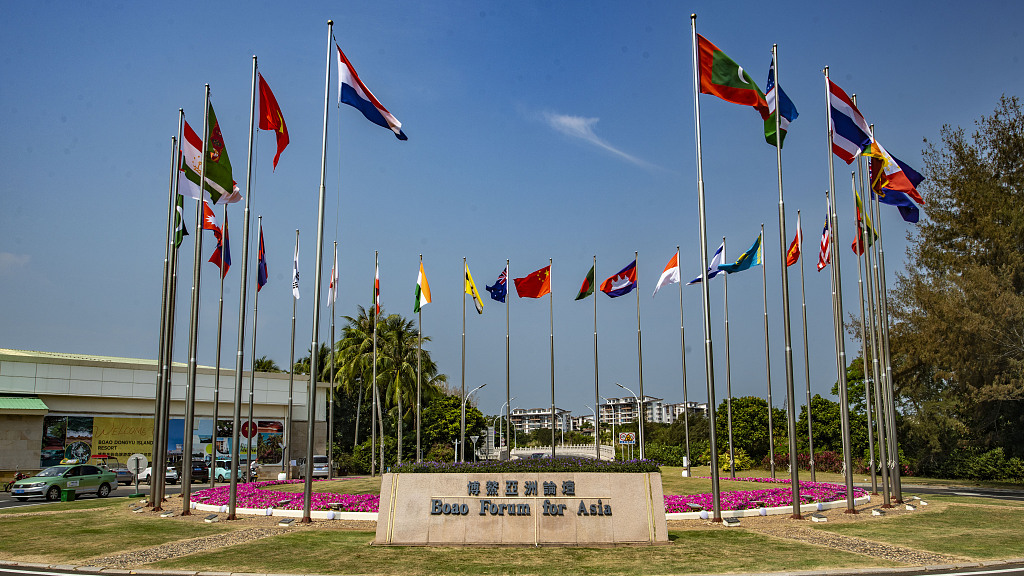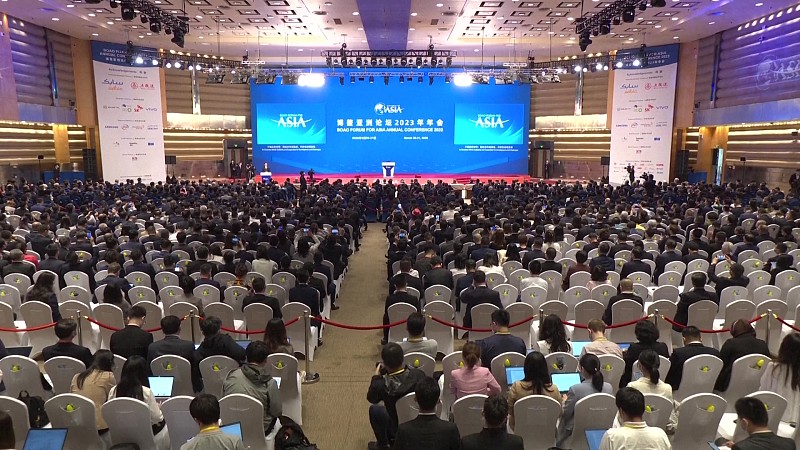
Flags flutter outside the venue of the Boao Forum for Asia in Boao, south China's Hainan Province, March 22, 2023. /CFP
Flags flutter outside the venue of the Boao Forum for Asia in Boao, south China's Hainan Province, March 22, 2023. /CFP
Editor's note: Xin Ge is an associate professor at the School of Public Economics and Administration, Shanghai University of Finance and Economics. The article reflects the author's opinions and not necessarily the views of CGTN.
The Boao Forum for Asia (BFA) annual conference, held annually in Boao, Hainan province, since 2001 to promote economic integration in the region, this year has sent an inspiring message in face of the lingering impact of the COVID-19 pandemic, the Russia-Ukraine conflict and volatilities in the financial sector. Its call is for global collaboration and development while addressing new opportunities in Asian regional cooperation to overcome economic hurdles.
According to the annual flagship economic outlook report released at the conference, "Deepened financial integration in Asia has made regional economies more resilient against negative impacts from international capital flows." The report predicted the real GDP in Asia will grow 4.5 percent this year, up from 4.2 percent in 2022, making the region a global "bright spot" in the bleak global economic landscape.
Asia is also expected to “accelerate its pace of overall economic growth, continue to advance regional production, trade, investment and financial integration and cohesion, and seize the 'Asian moment' for global economic governance." Despite the deteriorating global labor market and sluggish job growth in some Asian countries, Asia would have a better-than-expected employment situation.
However, at the same time, another report on sustainable development of Asia warned that "many low- and middle-income countries are encountering massive development challenges amid multiple crises, such as inflation, earthquakes, drought, floods, supply chain disruptions, food and energy shortages and climate change." Addressing all this requires multilateral cooperation and mixed financial measures to fill in the development funding gaps across the region.

The Boao Forum for Asia Annual Conference 2023 opens in Boao, south China's Hainan Province, March 30, 2023. /CFP
The Boao Forum for Asia Annual Conference 2023 opens in Boao, south China's Hainan Province, March 30, 2023. /CFP
China's importance in driving Asian growth cannot be overemphasized. Domestic economic prospects are improving, with a predicted growth of 5.3 percent this year, up from 3 percent in 2022. According to the IMF, each percentage point increase in China's GDP growth will raise the output of other Asian regions by about 0.3 point. China's high-quality development and opening-up have spurred rapid recovery, which also becomes a key factor in steadying the global economy.
Notably, Singapore's Prime Minister Lee Hsien Loong and Malaysia's Prime Minister Anwar Ibrahim paid an official visit to China on the margins of the annual conference. Their visits highlight cooperation in the economic realm, given China's position as a top trading partner of Southeast Asia.
Lee's six-day official visit to China follows a visit by Singapore's foreign minister to Beijing last month. During the meeting with the Chinese foreign minister, the two sides pledged to step up cooperation in emerging sectors such as the digital and green economies.
The ties between China and Singapore have been tighter than ever. The China-Singapore Free Trade Agreement was implemented in 2009 and subsequently, cooperation under the Belt and Road Initiative was incorporated into it to spur all-around bilateral collaboration. In November 2021, China formally applied to join the Digital Economy Partnership Agreement proposed by Singapore, New Zealand and Chile.
Chinese-made 5G communication equipment is widely adopted in Singapore, and the Chinese company Alibaba is the parent company of Lazada, one of Singapore's e-commerce giants. In 2022, China's trade with Singapore grew 22.8 percent to a value of $115.1 billion, Chinese customs data showed.
For the new Malaysian prime minister, it is his first official visit to China after taking office. The relations between Malaysia and China had been strong under former Malaysian Prime Minister Najib Razak, who not only approved the two countries' comprehensive strategic partnership, but also endorsed the Belt and Road.
Specifically, the collaboration in hi-tech industries witnessed the building of the China-Malaysia Qinzhou Industrial Park in Guangxi Zhuang Autonomous Region in south China and the Malaysia-China Kuantan Industrial Park on Malaysia's east coast. From January to November last year, China-Malaysia bilateral trade reached $184.75 billion, a year-on-year increase of 18.5 percent.
Additional data shows that Chinese investment accounted for 55.6 percent of Malaysia's total foreign direct investment in the first half of 2022, totaling at $11 billion.
The BFA demonstrates China's resolve to expand reform and opening-up and its sense of responsibility through the continued promotion of international and regional economic exchanges and cooperation. As Asia accounts for almost half of the world's economic output, Asia's further integration and cooperation are imperative to stabilize multilateralism as a ballast stone for global economic growth.
(If you want to contribute and have specific expertise, please contact us at opinions@cgtn.com. Follow @thouse_opinions on Twitter to discover the latest commentaries in the CGTN Opinion Section.)